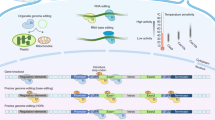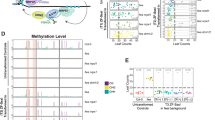Abstract
Transposable elements constitute a large portion of eukaryotic genomes and contribute to their evolution and diversification. Miniature inverted-repeat transposable elements (MITEs) constitute one of the main groups of transposable elements and are distributed ubiquitously in the genomes of plants and animals1 such as maize2,3,4,5, rice3, Arabidopsis6,7, human8, insect9,10 and nematode11. Because active MITEs have not been identified, the transposition mechanism of MITEs and their accumulation in eukaryotic genomes remain poorly understood. Here we describe a new class of MITE, called miniature Ping (mPing), in the genome of Oryza sativa (rice). mPing elements are activated in cells derived from anther culture, where they are excised efficiently from original sites and reinserted into new loci. An mPing-associated Ping element, which has a putative PIF family5 transposase, is implicated in the recent proliferation of this MITE family in a subspecies of rice.
This is a preview of subscription content, access via your institution
Access options
Subscribe to this journal
Receive 51 print issues and online access
$199.00 per year
only $3.90 per issue
Buy this article
- Purchase on Springer Link
- Instant access to full article PDF
Prices may be subject to local taxes which are calculated during checkout



Similar content being viewed by others
References
Feschotte, C., Jiang, N. & Wessler, S. R. Plant transposable elements: where genetics meets genomics. Nature Rev. Genet. 3, 329–341 (2002)
Bureau, T. E. & Wessler, S. R. Tourist: A large family of small inverted repeat elements frequently associated with maize genes. Plant Cell 4, 1283–1294 (1992)
Bureau, T. E. & Wessler, S. R. Mobile inverted-repeat elements of the Tourist family are associated with the genes of many cereal grasses. Proc. Natl Acad. Sci. USA 91, 1411–1415 (1994)
Zhang, Q., Arbuckle, J. & Wessler, S. R. Recent, extensive, and preferential insertion of members of the miniature inverted-repeat transposable element family Heartbreaker into genic regions of maize. Proc. Natl Acad. Sci. USA 97, 1160–1165 (2000)
Zhang, X. et al. P instability factor: an active maize transposon system associated with the amplification of Tourist-like MITEs and a new superfamily of transposases. Proc. Natl Acad. Sci. USA 98, 12572–12577 (2001)
Surzycki, S. A. & Belknap, W. R. Characterization of repetitive DNA elements in Arabidopsis. J. Mol. Evol. 48, 684–691 (1999)
Casacuberta, E., Casacuberta, J. M., Puigdomenech, P. & Monfort, A. Presence of miniature inverted-repeat transposable elements (MITEs) in the genome of Arabidopsis thaliana: Characterization of the Emigrant family of elements. Plant J. 16, 79–85 (1998)
Smit, A. F. A. & Riggs, A. D. Tiggers and other DNA transposon fossils in the human genome. Proc. Natl Acad. Sci. USA 93, 1443–1448 (1996)
Tu, Z. Molecular and evolutionary analysis of two divergent subfamilies of a novel miniature inverted repeat transposable element in the yellow fever mosquito Aedes aegypti. Mol. Biol. Evol. 17, 1313–1325 (2000)
Feschotte, C. & Mouches, C. Recent amplification of miniature inverted-repeat transposable elements in the vector mosquito Culex pipiens: Characterization of the Mimo family. Gene 250, 109–116 (2000)
Surzycki, S. A. & Belknap, W. R. Repetitive-DNA elements are similarly distributed on Caenorhabditis elegans autosomes. Proc. Natl Acad. Sci. USA 97, 245–249 (2000)
Raina, S. K. Doubled haploid breeding in cereals. Plant Breed. Rev. 15, 141–186 (1997)
Morishima, H., Sano, Y. & Oka, H.-I. Evolutionary studies in cultivated rice and its wild relatives. Oxf. Surv. Evol. Biol. 8, 135–184 (1992)
Yu, J. et al. A draft sequence of the rice genome (Oryza sativa L. ssp. indica). Science 296, 79–92 (2002)
Hirochika, H., Sugimoto, K., Otsuki, Y., Tsugawa, H. & Kanda, M. Retrotransposons of rice involved in mutations induced by tissue culture. Proc. Natl Acad. Sci. USA 93, 7783–7788 (1996)
Wessler, S., Tarpley, A., Purugganan, M., Spell, M. & Okagaki, R. Filler DNA is associated with spontaneous deletions in maize. Proc. Natl Acad. Sci. USA 87, 8731–8735 (1990)
Hirano, H.-Y., Eiguchi, M. & Sano, Y. A single base change altered the regulation of the Waxy gene at the post-transcriptional level during domestication of rice. Mol. Biol. Evol. 15, 978–987 (1998)
Kikuchi, K. et al. Molecular analysis of the NAC gene family in rice. Mol. Gen. Genet. 262, 1047–1051 (2000)
Yano, M. et al. Hd1, a major photoperiod sensitivity quantitative trait locus in rice, is closely related to the Arabidopsis flowering time gene CONSTANS. Plant Cell 12, 2473–2483 (2000)
Nakazaki, T. et al. Mobilization of a transposon in the rice genome. Nature this issue
Feschotte, C. & Mouches, C. Evidence that a family of miniature inverted-repeat transposable elements (MITEs) from the Arabidopsis thaliana genome has arisen from a pogo-like DNA transposon. Mol. Biol. Evol. 17, 730–737 (2000)
Barry, G. F. The use of the Monsanto draft rice genome sequence in research. Plant Physiol. 125, 1164–1165 (2001)
Hiei, Y., Ohta, S., Komari, T. & Kumashiro, T. Efficient transformation of rice (Oryza sativa L.) mediated by Agrobacterium and sequence analysis of the boundaries of the T-DNA. Plant J. 6, 271–282 (1994)
Negishi, T., Fujimura, T. & Sakurai, M. The efficient method of production of rice haploid-plants. Japanese Patent 06–036698 B (1994).
Acknowledgements
We thank T. Tanisaka for providing information on Sairyu before publication; T. Fujimura for technical advice on anther culture; S. Iida for critically reading the manuscript; and the Monsanto Rice–Research.Org Program for making available a draft of japonica genomic sequences.
Author information
Authors and Affiliations
Corresponding author
Ethics declarations
Competing interests
The authors declare that they have no competing financial interests.
Rights and permissions
About this article
Cite this article
Kikuchi, K., Terauchi, K., Wada, M. et al. The plant MITE mPing is mobilized in anther culture. Nature 421, 167–170 (2003). https://doi.org/10.1038/nature01218
Received:
Accepted:
Issue Date:
DOI: https://doi.org/10.1038/nature01218
This article is cited by
-
Comprehensive Analysis of the DnaJ/HSP40 Gene Family in Maize (Zea mays L.) Reveals that ZmDnaJ96 Enhances Abiotic Stress Tolerance
Journal of Plant Growth Regulation (2024)
-
Molecular and biochemical characterization of rice developed through conventional integration of nDart1-0 transposon gene
Scientific Reports (2023)
-
Identification and characterization of transposable element AhMITE1 in the genomes of cultivated and two wild peanuts
BMC Genomics (2022)
-
Datura genome reveals duplications of psychoactive alkaloid biosynthetic genes and high mutation rate following tissue culture
BMC Genomics (2021)
-
Detection of somaclonal variations in tissue cultured date palm (Phoenix dactylifera L.) using transposable element-based markers
Plant Cell, Tissue and Organ Culture (PCTOC) (2020)
Comments
By submitting a comment you agree to abide by our Terms and Community Guidelines. If you find something abusive or that does not comply with our terms or guidelines please flag it as inappropriate.



